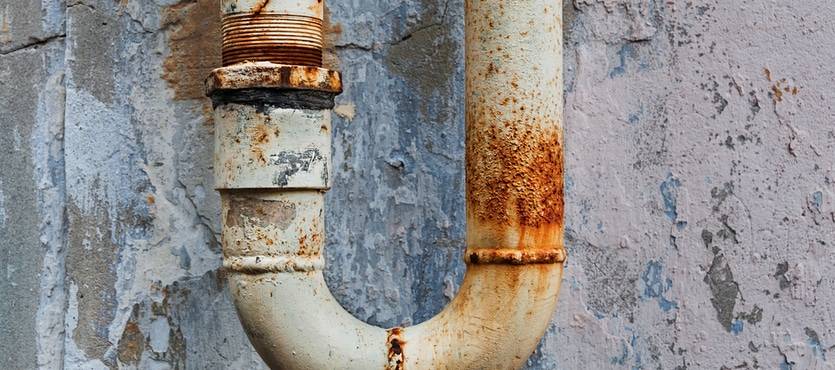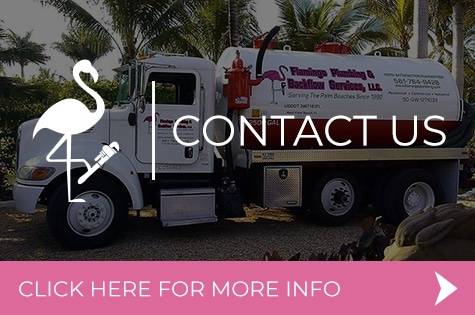Pipe corrosion is one of the most damaging forms of failure for private, industrial or commercial property owners. This form of corrosion usually goes undetected until a leak or a number of leaks, damage from water, the onset of mold, or some other sign of damage occurs that indicates there is a problem. Property owners face not only the costs to repair or upgrade systems (plumbing, HVACs, chiller water systems, fire sprinklers and other system types), but costs associated with repairing damaged property as well. One of the main objectives of performing a failure analysis is to determine not only the root cause of failure, but also to assign the liability for these costs. This is often the case where there are differing opinions or disputes involving insurance claims or where litigation is involved.
As a materials testing firm specializing in corrosion we offer a variety of analytical procedures that range from leak detection to identifying the underlying, or root, cause of failure. The Table below lists some of the more common procedures performed at Matco.
- Pipe / Plumbing System Failure Analysis
- Water Treatment Program Design, Evaluation, Monitoring, Trouble-Shooting
- On-Site and Cause of Damage Inspection
- HVACs, Fire Sprinkler Systems
- Leak Detection by Ultrasonic Testing
- Open and Closed Systems
- Lab Testing and Metallurgical Evaluations to Determine Root Cause and Mode of Failure
- Surface & Deposit Analysis
- Metallographic Analysis and Investigations
- FEA and Engineering Mechanics Analysis
- Preventative Maintenance and System Repair Recommendations
- Home Owner, Insurance Company, Attorney Litigation Support Representation
- Office Buildings, Hi-Rise Apartment / Condominum Buildings, Universities, Hotels, Schools / Universities,
- Hospitals, etc.
- Water Damage Evalaution and Recommendations for Corrosion Risk
- Training Seminars
- Accident Investigations
Copper Pipe Corrosion Induced Failures
Two distinct forms of corrosion are common to copper piping systems including non-uniform or uniform corrosion, both of which are related to the chemistry of the water including low pH and high alkalinity, and the presence of nitrates or sulfates. Non-uniform corrosion or pitting exhibits deep, narrow, isolated (localized) corrosion cells that can often cause rapid penetration of the substrate that lead to pinhole leaks that can cause water damage and or mold growth. Pitting corrosion is surrounded by non-roded surface, while uniform corrosion has a relatively uniform deposition of copper corrosion by-products across the interior pipe wall.
Pitting of copper alloys is promoted in the presence of ammonia, steam with sufficiently high levels of
CO2, O2 or HN3, sulfides in waters, and iron oxide from upstream corrosion of iron and steel. Three classifications for pitting corrosion are as follows:
-Type I
Cause: Hard Water
Type I pitting is associated with hard or moderately hard waters with a pH between 7 and 7.8, and it is most likely to occur in cold water. The pitting is deep and narrow, and results in pipe failure.
-Type II
Cause: Soft Water
Type II pitting occurs only in certain soft waters, with a pH below 7.2 and occurs rarely in temperatures below 140° F. The pitting that occurs is narrower than in Type I, but still results in pipe failure.
-Type III
Cause: Cold, Soft Water High PH
Type III pitting occurs in cold soft waters having a pH above 8.0. It is a more generalized form of pitting, which tends to be wide and shallow and results in blue water, byproduct releases, or pipe blockage.
Another form of corrosion of internal areas of copper piping that is less common is erosion corrosion, which is associated with the flow rate (velocity) of water traveling through pipe walls, turbulence, or suspended solids. This takes place when copper pipe is installed that is not sufficiently large enough in diameter to accommodate the pressure and flow rate of the water traveling through. These pipe systems will typically experience a higher corrosion rate in areas where protectives coatings are eroded potentially causing damage to the entire system. The area of greatest concern is where the water is forced to change flow direction, such as at elbows and tees.
Determination of the root cause of failure of systems or components can be very complex, and may require multidisciplinary testing and analysis. The first requirement for success is having a full-equipped modern laboratory. Matco’s labs include light and electron microscopy, mechanical and electrochemical testing, chemical characterization, and fracture mechanics/FEA analysis capabilities.
The other half of the battle is having the right staff. Matco‘s staff includes experienced PhD-level Metallurgists, and Materials and Mechanical Engineering Scientists; Professional Engineers; Chemists; Paint and Coating Specialists; and NACE (National Association of Corrosion Engineers) Certified Corrosion Engineers, Materials Selection/Design, Coatings and Cathodic Protection Specialists. By combining the right equipment with the right staff, rapid and accurate determinations of the causes of failure can be made.
Matco staff have written several publications including the following on pipe or plumbing system corrosion or other failure types commonly found in
Failure Analysis and Investigation Methods for Boiler Tubes
Microbial Influenced Corrosion, Victaulic Couplings, Water Treatment and DNA Studies
Boiler Feed Water Pipe Failure by Flow-Assisted Chelant Corrosion
A Re-Examination of Failure Analysis
Case History–Corrosion Failure Analysis of Copper Pipe at New York Hotel
Matco Services, Inc. was retained to determine cause of copper pipe leakage at a hotel located in New York. The pinhole leaks, which are temporarily repaired using rubber patches fastened with hose clamps, are continually affecting mostly ¾-inch recirculating hot water pipe but also larger diameter water pipe.
The hotel is approximately 20 years old and leakages have occurred with increasing frequency in the last several years, requiring temporary shutdowns of parts of the hotel to replace leaky pipe. Similar costly problems have been experienced in several other buildings of similar vintage in the vicinity, in which the pipe was installed by the same plumbing contractors.
The hotel water is treated by a Water District using several source water wells. The incoming domestic water is filtered through a vessel containing calcareous filtration media and serviced by a water supplier, who also performs quarterly water testing.
Results and Discussion:
Onsite Evaluations
Photographs taken at the hotel showing the areas of focus, including the Generator Room and Boiler Room. Pitting corrosion was evident in the boiler room and second floor work area, and key pipe samples were obtained from those locations. The additional test methods used to evaluate pipe corrosion are identified below.
Electrical potential measurements were used to determine if stray currents are presents. Less than or equal to 0.01 millivolt continuity was established, which shows all currents are electrically common. Galvanic Corrosion, or Not? Onsite observation and subsequent laboratory analysis showed that galvanic corrosion due to dissimilar metal contact is not an operative mechanism causing the copper pitting.
Analysis of other corrosion products found near copper pipe show a basic pH between 8.9 and 9.4. Ultrasonic thickness testing was conducted indicating a variation of 0.020 inch to 0.030 inch in the limited inspection areas, and does not indicate substantial uniform corrosion loss on the pipe ID surfaces. The localized pinhole nature of the damage was confirmed.
Lab Evaluation:
Laboratory analysis of the copper pipe pitting (ID and OD deposits) was performed before and after the onsite investigation. The following conclusions were drawn based on test results from the onsite investigation and laboratory testing:
The main chemical constituents other than copper were chlorine, sulfur, silicon, aluminum, and oxygen. These represent corrosive salts that are especially concentrated at the bottom of an active pit that has not yet penetrated all the way from the ID to the OD. These chemical species, especially chloride and sulfate, are corrosive to freshly exposed copper and are unquestionably driving the pitting corrosion through the pipe wall.
Water samples taken at the hotel were analyzed. It was found the water is abnormally demineralized and chemically unstable due to filtration and other treatment processes to remove chemicals and disinfect the incoming well water for distribution. The result is a high quality potable water but one that is aggressive to interior pipe surfaces and likely prevented a more protective natural copper oxide film from forming on the ID during the service life.
Cause of Failure: The root cause of failure is determined to be the result of interactions of chemical species in aggressive municipal water–this may be currently produced water and/or previously produced water–with the interior of the copper pipe that allowed the hard tenacious deposits to form.
Case History–Evaluation of Corroded Copper and Iron Water Pipes at Golf Course and Resort
A client was experiencing persistent corrosion problems in the water pipes at a golf course and resort. Matco Services was contracted to determine the root cause of corrosion of the pipe system and to provide recommendations for water treatment. A description of the site work is summarized as follows:
The hotel annex hot water is on a recirculating system, and the pipes were reportedly replaced in 1999. Flow rates within the 1.25” diameter pipe are reportedly a maximum of 100 gallons/minute (gpm). The annex water is from both domestic wells and an allowance of city water (up to 150,000 gallons/day). Chlorine is monitored twice daily with automatic chemical feeder additions. The condenser water chiller pipe has been in service only 8 months. The condenser, with copper tubes, is in service 11 months per year, and water treatment is reportedly conducted by an outside service. Samples were collected for subsequent lab testing.
Lab Evaluation:
As Received Observations (2 examples of samples evaluated):
The OD portions of the 1.25” diameter copper hot water pipes from the hotel annex exhibit heavy white deposits on the elbows with occasional green and yellow deposits. Upon splitting, the pipes exhibit a tenacious light brown deposit which overlies a dull grey-black deposit. The ID of the 6” diameter iron pipe is characterized by numerous small rust colored corrosion tubercles with occasional grey longitudinal artifacts. Black magnetic corrosion products underlie the tubercles. Evaluation of the pipe ID corroded surfaces using a dilute hydrochloric acid did not produce a rotten egg (H2S) smell.
Combined with the magnetic nature of the black deposits, it is suggested that the corrosion occurrence is not associated with microbiologically induced sulfate reducing bacteria. At one position within the pipe (reportedly 6 o’clock position in service) adjacent to the flange assembly, three large deep corrosion pits are observed.
Surface and Cross Section Examinations: Horseshoes and comet tails, vestiges of erosion, will align themselves with the flow direction. The alignment of the comet tails and horseshoes observed are not always aligned along the longitudinal axis of the pipe, suggesting that turbulence is associated with the erosion as may result from the high flow rate of water through the pipe elbows. Longitudinal cross section metallographically prepared samples show that the erosion has penetrated through more than half of the wall thickness in the areas examined.
The solder joint in the straight 1” cold water copper pipe length indicates that one side of the joint is shown to be tight, but free of any solder, as compared to the other side of the joint with solder penetrating almost to the end of the joint. No defects other than the incompletely sealed joints were observed on this pipe sample, and the OD deposits are considered to be attributable to leaks resulting from the poorly soldered joints.
The surface and polished cross section of the 5/8” hot water laundry room copper pipe indicate the characteristic of the ID surface are typical of erosion corrosion. The mechanism results from a repetitive cycle of surface deposit formation, breakdown and removal of the deposit with high flow rates, and reformation of the deposits. The various stages of this cycle are clearly depicted by the copper, green and black areas of the ID surface. A scanning electron microscope (SEM) image more clearly resolves the surface topography, and reveals the clear presence of erosion artifacts. Cross section metallographic examination shows up to 50% wall thinning has resulted in the sample area examined.
The surface and polished cross section metallographic specimens of the condenser iron pipe indicate surface topographies of the typical pipe ID and deep pitted areas. The photographs suggest that the deep pits result from the removal of progressive layers of the general corrosion on the pipe surface by erosion. It should also be pointed out that the pipe is not iron, but is a hot rolled carbon steel exhibiting a microstructure of ferrite plus lamellar carbide with banding and inclusion clusters oriented in the rolling direction.
SEM/EDS Analyses: Samples of the deposits present on the OD and ID surfaces of the submitted samples were obtained for examination using a scanning electron microscope (SEM) and semiquantitative chemical composition analysis using and energy dispersive spectroscopy (EDS). The SEM/EDS analyses reveal several interesting findings with regard to the corrosion issues displayed by these samples. Theresults are generalized by the following discussions.
In erosion corrosion, as displayed by the 1.25” hotel annex and laundry room hot water pipe samples, the turbulence of the water inside the pipe disrupts and removes the normally formed protective cuprous oxide and carbonate films. This stage is flow-induced erosion. The bared copper reforms the protective cuprous oxide, but subsequent turbulence again removes to oxide. Repetitive formation and removal results in the observed erosion of the pipe surface and erosive effects are enhanced with time by the accumulation of erosion debris solids suspended in the water.
The 1” hotel annex cold water pipe sample does not exhibit erosion corrosion, and the only deficiencies observed are the poorly soldered joints. The presence of zinc and tin in the corrosion debris from the OD of the pipe sample confirm that water leakage through the joints is the cause of the OD deposits. The adherent greenish-yellow deposit over the dark cuprous oxide on the ID surface is likely a combination of copper compounds (oxide, chloride, carbonate) provides additional corrosion protection. Although not observed in the submitted sample, localized breakdown could lead to pitting corrosion.
SEM/EDS analysis of the condenser iron pipe reveals the unusual presence of copper in association with the corrosion
products. The electrochemical potential of copper is more noble than that of iron, and copper deposits can set up local galvanic corrosion cells where the iron is anodic (corroding) to the copper (cathodic or protected). The likely source of copper is from the copper tubes of the condenser. Copper deposition is unlikely in flowing condenser water, but it is reported that the condenser is idled for 1 month/year. After the corrosion cell initiates at the copper deposits and tubercles are formed, the corrosion process can further propagate by under-deposit corrosion due to local differences in oxygen. The ID surface condition of the pipe as newly installed is not known, but an oxidized (black) surface should be avoided to mitigate the possibility of corrosion initiation by oxygen differential beneath adherent scale (iron oxide).
Water Analysis:
All of the hotel annex waters (copper pipes) are neutral to alkaline (pH 7.7-8.1) and are hard, with high levels of total dissolved solids (TDS) and high conductivity. Low levels of manganese are found, and the chlorine levels are low to moderate for chloride induced corrosion concerns. Calculated Langlier indices of the waters indicate that they are generally in balance, and as observed, do have some tendency for forming protective deposits on the pipe ID surfaces.
The condenser water (iron pipe) is alkaline (pH 8.5) and is very hard with very high levels of conductivity and TDS. The copper content of the water is about 0.2 ppm, about the threshold level for copper deposit corrosion concerns. The Langlier index is negative, and calcium carbonate deposition is not anticipated (as observed). In the presence of dissolved oxygen, the lack of such deposition suggests a strong probability of corrosion, with or without the observed copper deposition.
Conclusions and Recommendations:
- Evaluations of 1.25” hot water copper pipes from the hotel annex indicate that the observed corrosion results from flow rate induced erosion. The erosion of the samples examined occurs in association with sharp radii on the elbow inside bends. The reported flow rates within the pipes are up to 10 times over the recommended limits.
- Erosion corrosion is also identified as the cause of failure of a straight run of 5/8” laundry room hot water copper pipe.
- Flow rate induced erosion will manifest itself into more damaging traditional erosion as the process stream is contaminated by hard deposits and corrosion debris.
- Erosion corrosion is mitigated by consideration of the following factors:
- Reduce Flow velocity.
- Increase pipe size.
- Avoid formation of turbulent flow by increasing bend radii and good fit-up.
- Reduce corrosivity of water.
- Filtration to remove suspended solids.
- Reduce temperature.
- Evaluations of a 1” cold water copper pipe from the hotel annex reveal poorly soldered joints accounting for the failure of the submitted samples.
Generally, the hotel annex waters are in balance and are observed to form protective cuprous oxide films and water deposits on the tube ID surfaces.
The condenser iron pipe sample (determined to be hot rolled carbon steel) exhibits tuberculation on the entire ID surface with deep pits occurring by erosion of the generally corroded surface at a high flow position. The water is indicated to contain copper, and copper induced corrosion and/or oxygenation are likely root causes of the general corrosion of the pipe.
Occurrences of the condenser feed water pipe corrosion may be mitigated by consideration of water chemistry (inhibitors, promote protective film formation, eliminate copper source), coating the pipe ID in the high wear area, use of a more corrosion resistant material and deaeration.
Matco would be pleased to assist you in additional evaluations of your waters and pipe failures. Such evaluations may include but not be limited to on-site examination and evaluations, additional wateranalyses (dissolved oxygen content), water corrosivity evaluations and specific water or materials and design recommendations.
This investigation has found the primary cause of corrosion of the annex copper hot water pipe to be associated with flow rate induced surface damage (erosion corrosion). The reported flow rates of up to 100 gpm for the 1.25” diameter pipes are approximately 10 times the recommended maximum flow rate. The 1” cold water pipe does not exhibit erosion corrosion, and exhibits a well formed protective deposit film, however, solder penetration of the joints on the sample provided are of very poor quality.
The condenser corrosion is a result of a poorly balanced water chemistry that will not form a protective deposit layer, combined with galvanic corrosion sites resulting from copper deposition, likely during the idle month when the unit is not in operation. There is also a possibility of oxygenation corrosion. The extensive pits appear to be a manifestation of erosion at isolated active corrosion sites.







